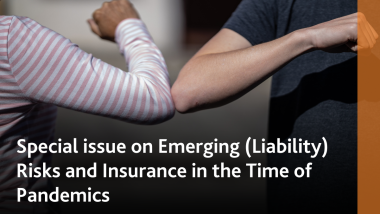Issue summary
Mortality improvements and shrinking healthspans are increasing longevity risks, putting increasing pressure on life insurers, individuals and governments around the world. The April 2024 special issue of The Geneva Papers on Risk and Insurance, edited by David Blake and Johhny Li, explores the challenges associated with this trend, including differences in life and healthy life expectancy and the growing need for long-term care (LTC), and ways to address them, such as new longevity-linked products and improved models for mortality forecasting.
Living longer, but not necessarily healthier
Healthy life expectancy – the number of years spent in good health – is generally failing to keep pace with overall life expectancy. This disjoint can differ quite markedly between areas within countries. In The great health challenge: levelling up the U.K., Les Mayhew, Mei Sum Chan and Andrew J.G. Cairns investigate the reasons for health inequalities in the U.K. They identify smoking as a major cause, with the number of years spent in ill health being greatest in areas with the highest mortality rates from smoking-related disease, and people who have never smoked enjoying six more years of good health at age 20 than current or ex-smokers. The paper suggests that a smoking ban would lead to a 2.5-year improvement in healthy life expectancy, but cautions that other measures, such as preventative healthcare, will also be needed.
The paper by by Jack C. Yue, Ming-Huei Tu and Yin-Yee Leong, A spatial analysis of the health and longevity of Taiwanese people, examines the urban-rural divide in life expectancy and healthcare utilisation in Taiwan. Their findings reveal persistent differences in mortality within the country – rates increase in mountainous territories and decrease in more populated areas. This is largely attributed to resource abundance in metropolitan areas, where medical care and employment prospects are superior.
Despite the fact that more people are living in poor health and require care towards the end of their lives, demand for long-term care (LTC) insurance remains low. In Using the Taiwan National Health Insurance Database to explore the need for long-term care, Jack C. Yue, Hsin-Chung Wang and Yizhen Liou investigate the reasons for this, using data from the Taiwan National Health Insurance Database to predict the future LTC population. They forecast that the number of people requiring LTC in Taiwan will reach 10% of the population by 2040, but various factors have challenged the implementation of LTC insurance, including issues around eligibility criteria and high premiums.
Alternative longevity-linked products
Income inadequacy in retirement is a growing risk as lifespans increase, particularly during prolonged periods of lower interest rates. Innovative, flexible products more suited to the longevity environment are needed to combat this problem. In A sustainable, variable lifetime retirement income solution for the Chilean pension system, Olga M. Fuentes, Richard K. Fullmer and Manuel García-Huitrón examine the merits of introducing a tontine – an investment plan in which participants buy shares in a common fund and receive an annuity that increases every time a participant dies – into the Chilean pension system. Their results show that tontine portfolios offer higher expected income streams than programmed withdrawals – the option currently being used by over 85% of pensioners in the country.
Dean Buckner, Kevin Dowd and Hardy Huller explore the suitability of equity release mortgages (ERMs) as pension fund investments in How suitable are equity release mortgages as investments for pension funds? These types of mortgages – also known as lifetime mortgages – have typically been recommended as appropriate investments for annuity providers and have more recently been touted as suitable for pension funds. However, the authors find them to be unsuitable for this purpose as they fail to meet the following criteria: 1) bear returns that are above the risk-free rate; 2) function as a good hedge for an annuity book; and 3) avoid high exposure to risks that annuity books are not subject to (e.g. house price risk). They therefore advise pension funds against investing in ERMs and instead recommend government bonds.
Improving mortality models
Bringing parametric mortality indexes to practice: a generalized CBD model with stochastic socioeconomic differentials in mortality improvements by Kenneth Q. Zhou, Johnny S.-H. Li and Pintao Lyu investigates the use of Cairns-Blake-Dowd mortality indexes as a hedging tool to mitigate longevity risk exposures, taking into account population basis risk, which has typically been disregarded in previous analyses. The authors also consider socioeconomic factors in their model, given the relevance of socioeconomic status for mortality. To illustrate the benefits of their novel hedging strategy, they use a hypothetical pension plan that includes members of various socioeconomic groups in the U.S.
Frailty is associated with an increased risk of all-cause mortality in older adults. In Frailty-based mortality models and reserving for longevity risk, Maria Carannante, Valeria D’amato, Steven Haberman and Massimiliano Menzietti propose a mortality model that incorporates frailty. The model is used to estimate premiums, technical provisions and risk measures for a range of standard insurance contracts to assess the impact of including frailty as a risk factor. The results show that the inclusion of a frailty factor allows the riskiness of an insurance portfolio to be measured better.
The framework offered in Machine learning in long-term mortality forecasting by Yang Qiao, Chou-Wen Wang and Wenjun Zhu can significantly improve the prediction accuracy of long-term mortality. Empirical analysis using data from various countries and regions in the Human Mortality Database confirms that the proposed framework reduces mean absolute percentage error in 20-year forecasting by almost 50% compared to classic stochastic mortality models.
Mortality improvement neural-network models with autoregressive effects by Hung-Tsung Hsiao, Chou-Wen Wang, I.-Chien Liu and Ko-Lun Kung incorporates cohort and autoregressive features into neural-network models for mortality predictions. The autoregressive effect allows past mortality rates to be taken into consideration when projecting future improvements, while the inclusion of cohort effects improves the accuracy of predictions. The authors compare the results of their models with five commonly used alternatives, and find that theirs outperform benchmark mortality models.
Access the issue at SpringerLink (subscription required): https://link.springer.com/journal/41288/volumes-and-issues/49-2








